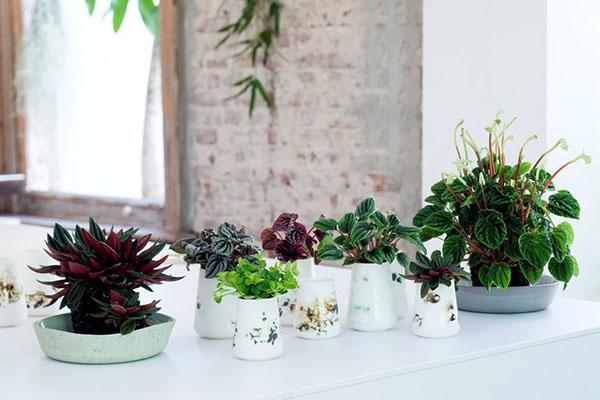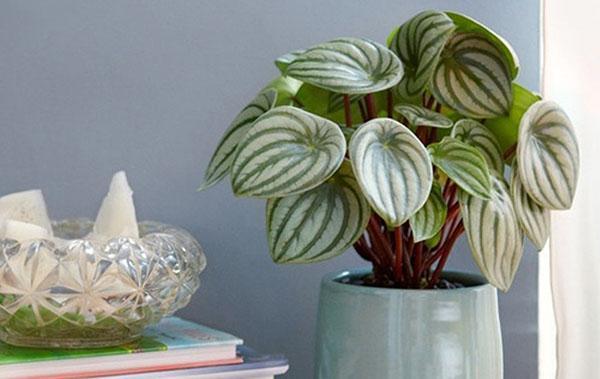What type of peperomia will you choose for yourself?
 Peperomias, striking with decorative foliage of various shapes and colors, are very popular with flower growers. To collect all types of alterations, the widest window sills in a spacious apartment are unlikely to be enough. Botanists have identified and described about 1200 species, most of which naturally inhabit the tropics of South America.
Peperomias, striking with decorative foliage of various shapes and colors, are very popular with flower growers. To collect all types of alterations, the widest window sills in a spacious apartment are unlikely to be enough. Botanists have identified and described about 1200 species, most of which naturally inhabit the tropics of South America.
It is not surprising that among such a variety there are ampelous and erect plants, species leading the lifestyle of a real succulent, and peperomias with long creeping shoots. With such a different appearance, all representatives of the genus bear one name, derived from the words peperi and omos, which translates as "percepian".
Flowering culture occurs in the spring and summer. Unlike foliage, spike-shaped inflorescences-candles of peperomia do not amaze with the brightness of color, but give the flower an original, memorable look.
Peperomia velvety (P. velutina)

Peperomia silvery (P. argyreia)
 One of the brightest varieties of the flower is silvery peperomia. The plant with short, profusely branching shoots attracts attention with glossy reddish petioles up to 10 cm long and bright silvery-green leaves. The leaf plates of the pointed-ovoid shape of this species are not monochromatic, but decorated with a series of light and dark stripes. In nature, plants of silvery peperomia grow both on the ground, and as epiphytes, settling on trees in a tropical forest.
One of the brightest varieties of the flower is silvery peperomia. The plant with short, profusely branching shoots attracts attention with glossy reddish petioles up to 10 cm long and bright silvery-green leaves. The leaf plates of the pointed-ovoid shape of this species are not monochromatic, but decorated with a series of light and dark stripes. In nature, plants of silvery peperomia grow both on the ground, and as epiphytes, settling on trees in a tropical forest.
The main decoration of the flower is smooth leaves, but no less decoratively peperomia looks in blooming form when greenish or slightly yellowish cobs of 4-6 cm rise above the deciduous rosette on long peduncles.
Peperomia gray-silver (P. griseo-argentea)
 The size of the rosette, the shape and structure of the leaves, this type of peperomia resembles a silvery variety, but the color of the leaf plates is different. There are no pronounced stripes here. The entire background of the glossy leaf has a rich silvery color, on which the crinkled relief created by the veins is very clearly visible.
The size of the rosette, the shape and structure of the leaves, this type of peperomia resembles a silvery variety, but the color of the leaf plates is different. There are no pronounced stripes here. The entire background of the glossy leaf has a rich silvery color, on which the crinkled relief created by the veins is very clearly visible.
Peperomia clusiifolia (P. clusiifolia)
 This indoor type of peperomia is distinguished by large, hard leaves that sit tightly on erect or drooping shoots. The length of oval leaves, elongated at the base, reaches a length of 15 cm. The expanding stems gradually lodge and take root in places of contact with the ground.
This indoor type of peperomia is distinguished by large, hard leaves that sit tightly on erect or drooping shoots. The length of oval leaves, elongated at the base, reaches a length of 15 cm. The expanding stems gradually lodge and take root in places of contact with the ground.
Among flower growers, the variegated flower shape is most appreciated. The front surface of the leaves of the peperomia cusielite is colored in bizarre green, white and pink-purple tones. The middle of the leaf plate is green, and the purple canvas along the edge of the green is separated by bright white or yellowish strokes.
Peperomia spotted (P. maculosa)
 Peperomia got its name due to the brownish-brown spots covering thick shoots, which can be both erect and semi-lying. This type is also called multi-spotted peperomia or dwarf pepper.Stems and cuttings of leaves can be smooth or covered with a short, barely noticeable nap. The pointed-cordate leaves are colored bright green. Against this background, thin light streaks are perfectly visible passing through the entire plate.
Peperomia got its name due to the brownish-brown spots covering thick shoots, which can be both erect and semi-lying. This type is also called multi-spotted peperomia or dwarf pepper.Stems and cuttings of leaves can be smooth or covered with a short, barely noticeable nap. The pointed-cordate leaves are colored bright green. Against this background, thin light streaks are perfectly visible passing through the entire plate.
The underside of the sheet peperomias spotted has a lighter color. During the flowering period, brown-purple, greenish or brown inflorescences are shown above the lush foliage. The height of such ears can reach 40-50 cm.
Peperomia reddish (P. rubella)
 A graceful perennial plant with drooping long shoots of a pinkish-purple hue. Unlike other species, small oval leaves of reddish peperomia sit on the stem not alternately, but opposite. Their upper side has a deep green color, the bottom plates are reddish. A short whitish pile is noticeable on both the stems and the foliage.
A graceful perennial plant with drooping long shoots of a pinkish-purple hue. Unlike other species, small oval leaves of reddish peperomia sit on the stem not alternately, but opposite. Their upper side has a deep green color, the bottom plates are reddish. A short whitish pile is noticeable on both the stems and the foliage.
Peperomia marble (P. marmorata)
 The broad-oval, fleshy leaves of the marbled peperomia are distinguished by a silvery-green background color. On it, blurry, light silvery spots concentrating near the veins are perfectly distinguishable. The erect stems of the herbaceous plant are painted in bright purple tones, which enhance the decorative effect.
The broad-oval, fleshy leaves of the marbled peperomia are distinguished by a silvery-green background color. On it, blurry, light silvery spots concentrating near the veins are perfectly distinguishable. The erect stems of the herbaceous plant are painted in bright purple tones, which enhance the decorative effect.
Peperomia creeping (P. serpens)
 A graceful perennial that resembles miniature ivy with sprouts lodging or hanging down as it grows will adorn any collection of a florist. In nature, creeping peperomia grows like an epiphyte, and its stems, strewn with pointed, heart-shaped leaves, hang freely along the tree trunks. The variegated variety of peperomia is the most decorative.
A graceful perennial that resembles miniature ivy with sprouts lodging or hanging down as it grows will adorn any collection of a florist. In nature, creeping peperomia grows like an epiphyte, and its stems, strewn with pointed, heart-shaped leaves, hang freely along the tree trunks. The variegated variety of peperomia is the most decorative.
Peperomia pleasant (P. blanda)
 Perennial peperomia, pleasant in height, reaches no more than 20-30 cm and forms a compact dense crown. The plant has erect branching shoots with oval leaves tightly sitting on them. The bright green of the upper side of the leaf blades looks great against the purple stems. Underneath, mature leaves are purple; on young leaves, this shade is weaker and may look like a border or spots along the veins. Small greenish inflorescences do not exceed one and a half centimeters in length.
Perennial peperomia, pleasant in height, reaches no more than 20-30 cm and forms a compact dense crown. The plant has erect branching shoots with oval leaves tightly sitting on them. The bright green of the upper side of the leaf blades looks great against the purple stems. Underneath, mature leaves are purple; on young leaves, this shade is weaker and may look like a border or spots along the veins. Small greenish inflorescences do not exceed one and a half centimeters in length.
Peperomia shriveled (P. caperata)
 The most popular type of peperomia in indoor floriculture amazes with the wrinkled textured surface of the leaves and an abundance of unusually beautiful varieties. The plant is compact and very small. A rosette of ovate leaves, sitting on long petioles, does not exceed 10-15 cm in height.
The most popular type of peperomia in indoor floriculture amazes with the wrinkled textured surface of the leaves and an abundance of unusually beautiful varieties. The plant is compact and very small. A rosette of ovate leaves, sitting on long petioles, does not exceed 10-15 cm in height.
 Depending on the variety, the stems and cuttings can be either a thick purple hue, or completely green or spotted. The leaves of shriveled peperomia also vary greatly. Their color ranges from deep green to purple. There are original variegated varieties with fancy foliage.
Depending on the variety, the stems and cuttings can be either a thick purple hue, or completely green or spotted. The leaves of shriveled peperomia also vary greatly. Their color ranges from deep green to purple. There are original variegated varieties with fancy foliage.
 The relief is achieved due to the sheet plate collected from the veins of the fabric. This plant variety blooms beautifully, showing white, brownish or pinkish buds above the rosette.
The relief is achieved due to the sheet plate collected from the veins of the fabric. This plant variety blooms beautifully, showing white, brownish or pinkish buds above the rosette.
Peperomia gray (P. incana)
 The title peperomia gray-haired owes to a grayish or silvery shade of broad-oval, almost rounded leaves. The original shade is provided by the whitish bristle covering both young foliage and shoots. A flower up to 50 cm in height readily bush and forms a compact crown of dense fleshy foliage.
The title peperomia gray-haired owes to a grayish or silvery shade of broad-oval, almost rounded leaves. The original shade is provided by the whitish bristle covering both young foliage and shoots. A flower up to 50 cm in height readily bush and forms a compact crown of dense fleshy foliage.
Peperomia blunt-leaved (P. obtusifolia)
 In nature, blunt-leaved peperomia is an inhabitant of the upper and lower tiers of the tropical forest. Plants feel equally well as an epiphyte and as a terrestrial species. Leaves on short petioles have an oval shape with a base tapering to the stem. The length of the leaf plate is 5–8 cm, the color can be different. Variegated varieties are in the highest esteem among flower growers.
In nature, blunt-leaved peperomia is an inhabitant of the upper and lower tiers of the tropical forest. Plants feel equally well as an epiphyte and as a terrestrial species. Leaves on short petioles have an oval shape with a base tapering to the stem. The length of the leaf plate is 5–8 cm, the color can be different. Variegated varieties are in the highest esteem among flower growers.
But there are also very bright varieties with dense green foliage, the color of which becomes darker and more saturated as it grows.
 The genus of peperomia is not limited to the specimens described.Several hundred species and even more varieties of this plant are at the disposal of amateur flower growers.
The genus of peperomia is not limited to the specimens described.Several hundred species and even more varieties of this plant are at the disposal of amateur flower growers.